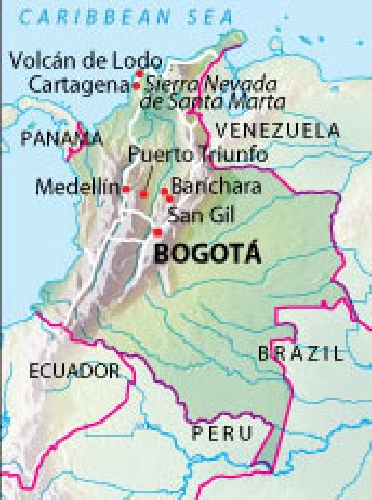
The former drug-lord's estate may seem an unlikely visitors' attraction, but it's an indication of a new approach to tourism in Colombia
Imagine the estate agent’s advertisement: “Deceased drug lord’s ranch on 15 sq km of prime Colombian pasture, 1,500m airstrip, 500-seat bullring, six life-sized dinosaur sculptures, collection of charred classic cars, 18 hippos, planning permission for a prison and theme park, in need of some tender loving care.”
This is the property that Oscar Orozco took on when his company offered to invest £25 million in Hacienda Napoles. Located 160km east of Medellín, Colombia’s second-biggest city, it’s no ordinary tropical retreat. Napoles was Pablo Escobar’s pleasure palace; this is where the drug lord held court over million-pound cocaine deals, met with shady underworld figures and partied with underage girls.
Now it’s being turned into an unlikely visitor attraction, as Colombia comes to terms with its history of cocaine cartels and guerrilla wars in a way that no one would have expected.
With backing from the Colombian government, Orozco has opened the doors on this slice of narco-memorabilia, after restocking the on-site zoo with zebras, a few llamas and an ostrich. He even coaxed the kingpin’s sculptor back from New Jersey to rebuild the ranch’s gaudy, concrete dinosaurs, dreamed up by Escobar long before Jurassic Park hit the big screen. There are new tiles on the roof in a bid to stage live music concerts and there are grand plans for an environmental reserve.
Yet it was only 15 years ago that the world’s most notorious drug smuggler was gunned down in a safe house in Medellín as he tried to escape from police. Looking back on that time, dinosaur sculptor Fernando Ojearte Montoya muses: “I was just lucky to survive.”
After El Patrón’s downfall his mansion and grounds were heavily looted and the comical-looking dinosaurs smashed, as prospectors tried to sniff out his bullion – not surprising since he was once listed by Forbes magazine as the world’s seventh-richest man.
Since then, the hippos are the only living things that have thrived at the ranch at Puerto Triunfo. Yes, hippos. Escobar originally installed three, but since then the population has swelled to 18, and for a £3 ticket you can now see their progeny bobbing in the verdant man-made ponds.
Other highlights of the tour include Escobar’s burned-out collection of old motor cars (including Al Capone’s gangster-mobile) and a pair of psychedelic tyrannosaurus chicks bursting out of eggs, while their mother does battle with a newly painted concrete triceratops.
“We looked at the possibility of an Escobar museum, but it’s still an open wound, so the government aren’t that interested,” explains Orozco. The heady mix of cocaine, murder and kidnapping is still too vivid in people’s minds here, and is the main reason why Escobar’s home itself has been left to rot. You can still stand in his bombed-out shower or walk around the algae-covered swimming pool where army chiefs were once seduced by whisky and American dollars.
“It is all to show that crime doesn’t pay,” pleads Montoya. This is why the government is constructing a 2,000-inmate prison on site. In a macabre twist, backers of Hacienda Napoles hope that families visiting their locked-up loved ones will also pay to visit Escobar’s home in their droves.
Turning the drug tsar’s playpen into a family fun day out is in many ways symbolic of the transformation that is occurring in Colombia. A nation once dubbed ‘Locombia’ – the mad country – for its spiralling homicide rates is now seeing soaring tourist numbers. Last year arrivals grew by 15% in the first seven months, nurtured by the government of President Álvaro Uribe, who has defanged many of the paramilitary and guerrilla groups. A new tourism slogan promises: “The only risk is wanting to stay.”
While areas of the country remain off-limits, the situation is improving. Cities and highways are safer, foreign investment is flowing in at a record pace and the economy is booming.
This optimistic vibe is already evident in Cartagena, the country’s main Caribbean resort town, which held its annual Hay Literary Festival late this January. Writers and literary luvvies gathered along its pastel-coloured streets to discuss the film Love in the Time of Cholera, adapted from Gabriel García Márquez’s book by British director Mike Newell. Despite mixed reviews, the sumptuous film is already boosting interest in Colombia further.
As I left Hacienda Napoles, Fernando begged me: “Write good things about my country, we have seen enough bad things. It has changed here.”
It certainly has, and – in a very Colombian way – for the better.